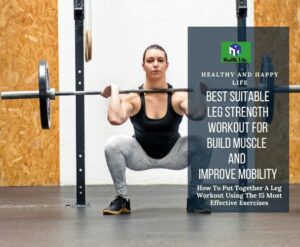Legs that are strong are beneficial in more ways than one. Leg strength is necessary for even the most basic of daily actions, such as walking. This indicates that including leg exercises as part of your regular regimen is essential to your overall health. In this article is going to examine about what are the most effective leg workout routine with 15 exercises?
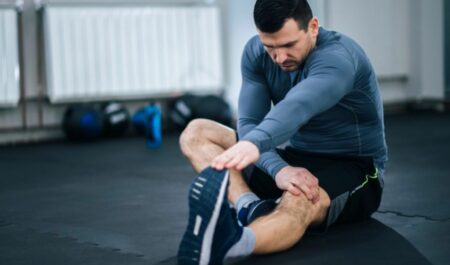
But You Might Be Wondering How To Get Started.
Putting together an efficient leg exercise doesn’t have to be difficult, regardless of whether you’re exercising at home in a pandemic-style workout or whether you’re back in the gym working up a sweat. Let’s dig in.
Movement Patterns That Are Included In An Effective Leg Workout.
When it comes to developing an effective leg exercise, keeping things as basic as possible is going to yield the best results. Your workout routine should be based mostly on lower body exercises such as squats, hip hinges (deadlifts), and lunges. This should be the case for the majority of your workouts.
The primary focuses of these exercises are the quadriceps, hamstrings, and glutes, which are the four major muscular groups found in the legs.
When you have these motions down pat, there are a lot of other variants and strategies to advance that will prevent you from becoming bored.
When planning your leg workout, here is a simple approach to split it down into its component parts: First, perform a squat, then transition to a hip-hinge action, and last, add in your single-leg exercises.
In your leg workout, how many sets and how many repetitions should you do?
Choose three to five different exercises for each leg workout if you are a novice and are wanting to improve your overall level of fitness while adhering to the principle of keeping things as simple as possible. Then, finish three sets of each exercise with eight to twelve repetitions, making sure that you are exercising your muscles to the point of fatigue but not failure.
Why limit yourself to no more than five exercises? You’ll be able to concentrate on those crucial movements, allowing you to play at your very best. Your workouts run the risk of being ineffective if they go on for too long.
How Many Times Should You Work Your Legs During The Week?
Recent studies have shown that there is not much of a difference in the amount of muscle growth that can be achieved by exercising the major muscle groups once per week as opposed to three times per week.
The intensity of your resistance training, measured in terms of the number of sets and repetitions you perform, is the factor that contributes the most to the rate at which your muscles expand. Working the same muscle area numerous times in a week typically produces worse results compared to doing sessions with a higher volume (for example, three sets of twelve repetitions or even four sets of eight reps).
How To Properly Warm Up And How To Properly Cool Down.
A thorough warmup and cooldown are essential components of every productive workout, yet they are often overlooked.
Aim to begin your warmup with five minutes of modest cardiovascular activity, with the goal of getting your heart rate up and blood flowing. If you have the time, try using the foam roller for some soft-tissue relief for a period of five minutes.
The next step is to perform a series of dynamic stretches, which should include exercises such as leg swings, hip openers, bodyweight squats, and lunges.
If you want to get the most out of your stretching regimen, you should save it until after your workout.
Exercises That You May Do As Part Of Your Leg Exercise.
Use this list of the 15 most effective leg exercises as a starting point for designing your next leg workout.
1. Back Squat.
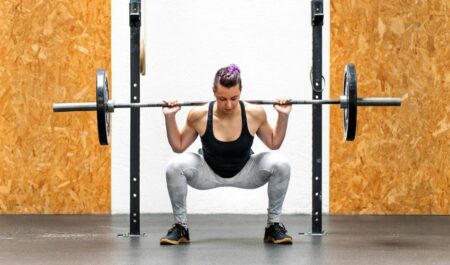
The back squat is an excellent exercise for working the posterior chain, which refers to the rear of the body and includes the glutes and hamstrings.
The proper way to do it:
- 1Stand with your feet slightly wider than shoulder-distance apart and a barbell loaded on your traps. Your eyes should be directed forward, your chest should be lifted high, and your toes should be angled outwards ever-so-slightly.
- 2Drop down toward the ground by bending your knees, sitting back into your hips, and lowering yourself into the ground. It is important to make sure that your knees move slightly outward and do not cave inward.
- You should squat down until your thighs are parallel to the ground, or as far as your mobility will allow you to go, and then push yourself back up to the starting position.
2. Front Squat.
A front squat allows you to focus on developing the front of your body, particularly your quadriceps.
The proper way to do it:
- When you are ready, load a barbell onto the front of your shoulders and support it by hooking your fingers in an underhand grasp on each side of your shoulders. Raise your elbows and retain your focus on what’s in front of you.
- Lower yourself toward the ground by bending your knees, sitting back into your hips, and lowering yourself down. Make sure that your legs are tracking outward and that your chest is staying proud while you fight the urge to collapse forward.
- You should squat down until your thighs are parallel to the ground, or as far as your mobility will allow you to go, and then push yourself back up to the starting position.
3. Romanian Deadlift.
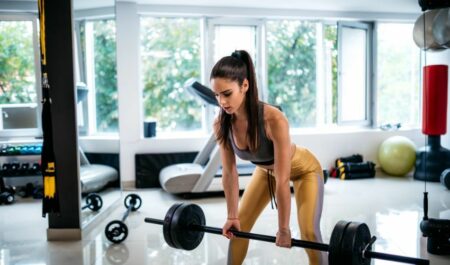
The Romanian deadlift is an excellent exercise for increasing mobility in the hips in addition to strengthening the glutes, hamstrings, and calves.
The proper way to do it:
- Keeping one barbell or dumbbell in each hand, perform the exercise. Throughout the action, be sure to keep both your back and your sight straight front of you.
- You should start by bending forward at the hips and dropping your weight toward the ground while simultaneously bending your knees slightly. Allow the weights to move in close proximity to the line of your legs as you lower them and continue to lower them until you feel a stretch in your hamstrings.
- After pausing, start standing up by thrusting your hips forward and allowing your glutes to provide the most of the strength.
4. Good Morning Workout.
The “good morning” exercise is a hip-hinge action that will help you wake up your hamstrings.
The proper way to do it:
- Stand with your feet slightly wider than shoulder-distance apart and a barbell loaded onto your traps.
- You should bend your knees slightly and hinge at the hips while you gently slide your body toward the ground, which will cause your butt to move in the opposite direction. Throughout the action, maintain your chest up high and your focus unwaveringly ahead of you.
- After lowering yourself to the point where you feel a stretch in your hamstring, return to the starting position by contracting your glutes.
5. Walking Lunges.
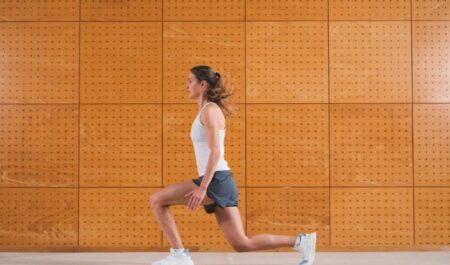
Walking lunges are a great way to strengthen your quads, hamstrings, and glutes, but they may also be challenging for your balance.
The proper way to do it:
- Put your feet next to one another to begin. If you want to practice weighted walking lunges, you need be sure you hold a dumbbell in each hand.
- Step forward and lunge forward with your right leg until your thigh is parallel to the ground while keeping your chest up and your vision fixed directly in front of you.
- You should be able to come back up to the beginning position by pushing up through your right heel.
- Keep moving forward while putting weight on your left foot.
6. Reverse Lunge.
The reverse lunge, which is a kinder variation of the forward lunge, is an excellent exercise for executing the optimum placement for a lunge.
The proper way to do it:
- You should stand with your feet slightly wider than your shoulders apart and your arms hanging loosely at your sides.
- Take a step backward with your right foot and lunge forward until the angle formed between your left leg and the ground is 90 degrees. Maintain an upright position in your torso.
- Return to the beginning position by bringing your weight up through your left heel.
7. Lateral Lunge.
As humans, the majority of our motion takes place in front-to-back planes of motion. Stability and strength may be improved by performing side-to-side motions like lateral lunges, for example.
The proper way to do it:
- To begin, spread your feet further apart than hip-width apart.
- Keep your body straight while bending your left knee and sitting back into your left hip. Keep your left knee bent. Maintain as much of a straight line as you can with your right leg as you bend your left knee to a 90-degree angle. Do this while keeping your right leg as straight as possible.
- Repeat when I tell you to push back up to the starting position. Carry out the allotted number of repetitions on each side.
8. Stepup.
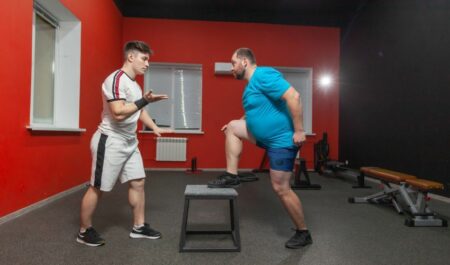
The stepup is a great exercise for improving your strength, balance, and power.
The proper way to do it:
- Place a seat or any other raised surface in front of you by a distance of about one foot as you stand. If you wish to perform a weighted step up, you will need to keep a dumbbell in each hand.
- You may either elevate your left knee for an additional challenge or step onto the bench with the entirety of your right foot. Then, push up through your heel to bring your left foot to meet your right foot, or you can do both.
- When you are ready, return to the beginning position by stepping down with your left foot.
9. Glute Bridge.
The only equipment you need for this workout is your own body weight.
The proper way to do it:
- Position yourself so that you are lying on your back with your knees bent, your feet flat on the floor, and your arms resting by your sides.
- Take a deep breath in and press through all four corners of your feet while activating your core, glutes, and hamstrings to bring your hips up as high as you can.
- After pausing at the peak, gradually lower yourself until you are in the beginning position.
10. Hip Thrust Workout
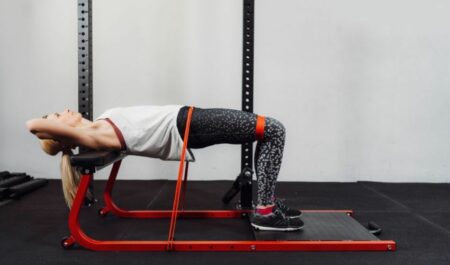
The hip thrust is a great exercise for developing your glutes’ strength and size.
The proper way to do it:
- Place a barbell, dumbbells, or a plate on your hips while you are seated on a raised surface such as a bench or sofa. Throughout the entirety of the activity, you will be required to use your hands to maintain the weight.
- To get into position, slide your back down the bench until your knees are bent and your feet are flat on the ground. Position your feet so that they are shoulder-width apart. Your thighs should be positioned such that they make an angle of ninety degrees, and the bench should be positioned so that it is directly below your shoulder blades.
- Keep your chin tucked in and your bottom toward the ground as you sink your butt. Reduce your height while maintaining a stable footing, and cease lowering yourself when your torso is at an angle of 45 degrees with the ground.
- Apply upward pressure via the soles of your feet until your thighs are once again perpendicular to the ground. At the height of the movement, squeeze your glutes, and then slowly return to the starting position.
11. Goblet Squat.
The goblet squat is a variation of the traditional squat that is less taxing on your back than the traditional squat, yet it still strengthens your quadriceps and glutes.
The proper way to do it:
- To begin, grab a dumbbell so that it is upright in your hand and position both hands so that they are beneath the top of the weight. Put the dumbbell up against your chest, and be sure to hold it there the whole time you’re doing out.
- Squat down, seating back into your hips while bending your knees. This is the starting position. Maintain an upright posture and bend forward as much as your range of motion will allow.
- Return to the beginning posture by bringing your weight up through your heels.
12. Leg Press.

Although machines like the leg press lack some of the benefits of free-weight exercises, they do allow you to quickly isolate certain muscles, in this case the quadriceps, hamstrings, and glutes. This is an advantage that free-weight exercises do not have.
The proper way to do it:
- Place your back and head on the pad that comes with the leg press machine while you sit on the seat. Position your feet so that they are hip-width apart. The angle formed by your legs should be 90 degrees.
- Put some effort into engaging your core, and stretch out your legs. At the top, take a moment to pause, but be careful not to lock your knees.
- Bending your knees will allow you to return the plate to its initial position more slowly.
13. Leg Curl.
Utilizing the leg curl machine, you can target your hamstrings and calves individually.
The proper way to do it:
- Place yourself in the leg curl machine so that you are resting on your stomach, and position the roller pad so that it is slightly above your heels. To stabilize yourself, grab the support bars that are located on either side of the machine.
- Engage your core muscles and elevate your feet while simultaneously pushing the pad closer to your butt.
- Make a little pause at the peak, and then slowly lower yourself back down to the starting position.
14. Bulgarian Split Squat.
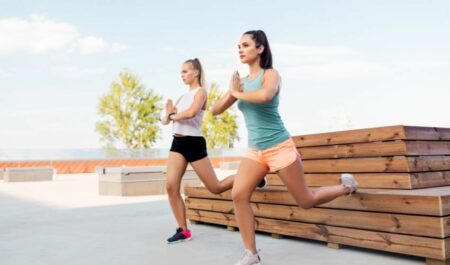
The Bulgarian split squat is a great exercise that works both your legs and your core.
The proper way to do it:
- Face away from a knee-level bench or step and stand approximately two feet in front of it. Raise your right foot behind you and rest the top of it on the bench. Lift your right leg behind you.
- Make a small forward lean at the waist, and while doing so, proceed to drop yourself down on your left leg while bending the knee. When your left thigh is parallel to the ground, you should stop moving forward.
- To return to a standing position, apply upward pressure via the sole of your left foot.
15. Single-Leg Deadlift.
By performing the single-leg deadlift, you may strengthen your hamstrings and improve your balance at the same time.
The proper way to do it:
- Take a hold of a set of dumbbells. Throughout the action, be sure to keep both your back and your sight straight front of you.
- Put your weight on your left leg and start to hinge at the waist while maintaining your left knee bent. This motion should be done while keeping your left knee soft.
- Your body should make a straight line from your head to your toes as you continue to lean forward and push your right leg up and back. Make sure that your hips remain level with the ground at all times.
- After pausing, proceed by moving back to the initial location and performing the action once more. Carry out the required amount of repetitions for each leg.
The Conclusion
When constructing a leg exercise, the most successful strategy, especially for those just starting out, is to keep things as straightforward as possible. Pick three to five exercises, focus on your form, and observe how quickly your leg strength improves.
